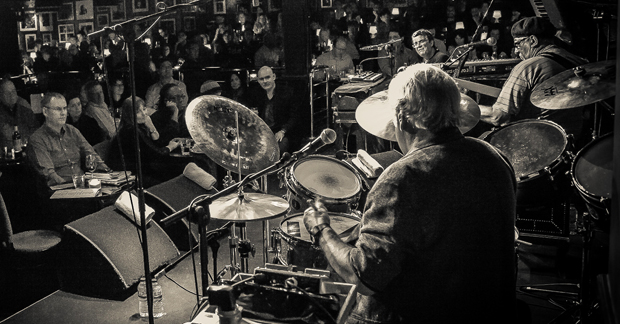Azymuth bring the Jazz Carnival to Ronnie Scott’s
Thursday, March 5, 2015
A rare moment at a jazz gig: a request not just for a song, but a chart hit.

The very expression is so foreign to the world of improvised music these days that some might be alienated by the audible pleas for ‘Jazz Carnival’, the track that took the Brazilian trio Azymuth into the UK top 20 in February 1980, squeezing them into a somewhat unique berth between The Beat and the Bee Gees. However the passion shrilling up among the front row faithful makes it clear that the track does indeed mean something to those of a certain age and culture, ‘soul boys’, for want of a better term, who vigorously loosened limbs to instrumental jazz-fusion in clubs as well as lending an ear to it front rooms.
Prior to that commercial breakthrough Azymuth already had a good decade of activity under their belts and the white hair and generous waistlines of drummer Ivan Conti and bass guitarist Alex Malheiros signal their place as elder statesmen in a form of Brazilian music that stirred the electronic innovations of Herbie Hancock and the aggressive funk of James Brown into the bubbling pot of local samba rhythms to cook up a sound that was both earthy and intricate.
Completing the trio is keyboardist Fernand Moraes, who is arguably under the greatest pressure as the replacement for the late founder member José Roberto Bertrami, the man who created the most vivid colours in the band’s tonal palette.
While Moraes plays satisfactorily for most of the evening there are moments when he is less expansive than his predecessor, and in the gentler bossa novas that are sprinkled throughout the first set he could have stretched out a touch more just to supply the kind of vigour that stopped Azymuth’s numerous studio sets, Outubro, Telecommunication and Cascade being among the most favoured, becoming too tepid. When the electric piano adds more gloss than grit one too many of the mid-tempo ballads simply flatline.
However, the band emerges for the second set with a renewed energy that grabs the audience by the scruff of the neck on the downbeat of the subtle but percolating ‘Light As A Feather’, the title track of the album that spawned the aforesaid Jazz Carnival and that remains arguably the definitive Azymuth studio recording, before peaking on the quite magnificent ‘Partido Alto.’ This is also the cue for Conti to come into his own as a front man, standing up and playing a ‘pandheiro’, a large tambourine and a ‘tamborim’, a small tambourine, to demonstrate the zigzag polyrhythms that form the basis of the piece before seamlessly transferring these patterns to the kit. Visually and aurally, it’s a great moment.

Conti’s rimshots are razor sharp, teasingly wrapping around Malheiros’ short, hiccupping bass lines while Moraes’ choppy Rhodes syncopations now have the kind of sting previously missing. The introduction of the song, which has the feel of cleverly adrenalinized reggae, works up a sweat before giving way to a gliding melody that in turn swerves into chord changes that set up Moraes’ fully engaged improvisations. While the chemistry between the players reaches a real highpoint here the overall sound canvas of the group is enriched by Conti’s secret weapon, an additional tom tom that has the crackling high pitch of a timbale. It is used more inventively than before and infuses an additional percussive barrage to the music that hints at the tightly controlled noisefest of a samba school.
Thereafter the dance implications of Azymuth’s music become more explicit and, although slightly undercooked, the very soulful ‘Dear Limmertz’ draws a huge round of applause before the inevitable rendition of ‘Jazz Carnival’ brings many members of the audience to its feet as the Ronnie’s rule of keeping conversation to a minimum is relaxed with no voices of dissent to be heard in the now raucous venue.
Exactly 35 years old the song is essentially a tasteful blend of jazz and funky disco that does indeed remind us that Azymuth was a product of its time and as Malheiros’ powers the groove along it’s easy to hear, and indeed see why the track captured the imagination of dancers around the world. Somewhat poignantly, the moment is also a marker of change, for there has been no real successor to ‘Jazz Carnival’, namely a piece of instrumental music that garners an audience big enough to make a dent in the national charts and hold its own alongside vocal-led pop. It is a challenge that players, listeners and mainstream radio programmers might do well to take up.
– Kevin Le Gendre
– Photos by Carl Hyde